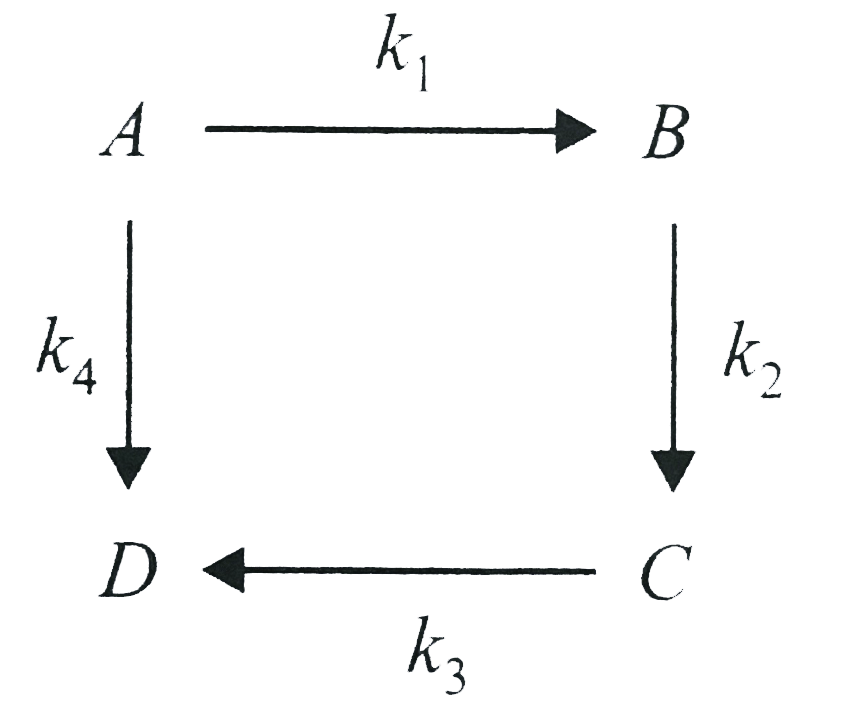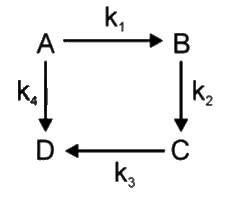An elementary reaction A and B is second order reaction. Which of the following rate equation must be correct?
The correct Answer is:D
To determine the correct rate equation for a second-order elementary reaction involving reactants A and B, we can follow these steps:
Step 1: Understand the Concept of Elementary Reactions
An elementary reaction is a reaction that occurs in a single step. The order of an elementary reaction is equal to its molecularity, which is the number of reactant molecules involved in the reaction.
Step 2: Identify the Molecularity
For the reaction A + B → Products, the molecularity is 2 because there are two reactant molecules (A and B) involved in the reaction.
Step 3: Relate Order and Molecularity
Since the reaction is second order, the sum of the powers of the concentration terms in the rate equation must equal 2. Therefore, if we denote the rate equation as:
Rate=k(A)x(B)y
then we have:
x+y=2
Step 4: Determine Constraints on x and y
- Both x and y must be greater than 0 because they represent the number of molecules reacting.
- Both x and y must be integers, as fractional orders would imply a complex reaction rather than an elementary one.
Step 5: Analyze the Given Options
Now, we need to evaluate the provided options based on the above criteria:
1. Option 1: Rate=k(A)2(B)0
- Here, x=2 and y=0. This option is invalid because y cannot be zero.
2. Option 2: Rate=k(A)3/2(B)1/2
- Here, x=3/2 and y=1/2. This option is invalid because both x and y are fractional.
3. Option 3: Rate=k(A)0(B)2
- Here, x=0 and y=2. This option is invalid because x cannot be zero.
4. Option 4: Rate=k(A)1(B)1
- Here, x=1 and y=1. This option is valid because x+y=2, both x and y are greater than zero, and they are integers.
Conclusion
The correct rate equation for the second-order elementary reaction A + B is:
Rate=k(A)1(B)1
An elementary reaction is a reaction that occurs in a single step. The order of an elementary reaction is equal to its molecularity, which is the number of reactant molecules involved in the reaction.
For the reaction A + B → Products, the molecularity is 2 because there are two reactant molecules (A and B) involved in the reaction.
Since the reaction is second order, the sum of the powers of the concentration terms in the rate equation must equal 2. Therefore, if we denote the rate equation as:
Rate=k(A)x(B)y
then we have:
x+y=2
- Both x and y must be greater than 0 because they represent the number of molecules reacting.
- Both x and y must be integers, as fractional orders would imply a complex reaction rather than an elementary one.
Now, we need to evaluate the provided options based on the above criteria:
- Here, x=2 and y=0. This option is invalid because y cannot be zero.
- Here, x=3/2 and y=1/2. This option is invalid because both x and y are fractional.
- Here, x=0 and y=2. This option is invalid because x cannot be zero.
- Here, x=1 and y=1. This option is valid because x+y=2, both x and y are greater than zero, and they are integers.
The correct rate equation for the second-order elementary reaction A + B is:
Rate=k(A)1(B)1
Topper's Solved these Questions
- BOOK - NARENDRA AWASTHICHAPTER - CHEMICAL KINETIC & NUCLEAR CHEMISTRYEXERCISE - Level 1 (Q.3 To Q.32)2videos
CHEMICAL KINETIC & NUCLEAR CHEMISTRY
- BOOK - NARENDRA AWASTHICHAPTER - CHEMICAL KINETIC & NUCLEAR CHEMISTRYEXERCISE - Level 1 (Q.33 To Q.62)3videos
CHEMICAL KINETIC & NUCLEAR CHEMISTRY
- BOOK - NARENDRA AWASTHICHAPTER - SURFACE CHEMISTRYEXERCISE - Level 3 - Assertion - Reason Type Questions1videos
SURFACE CHEMISTRY
Similar Questions
Knowledge Check
- Question 1 - Select One
Consider the elementary reaction sequence shown in figure. Which of the following equations are correct ?
 Ad[A]dt=−k1[A]+k4[D]Bd[C]dt=k2[B]−k3[C]Cd[D]dt=−k4[D]+k3[D]DNothing can be said about order of reactions in this problem.
Ad[A]dt=−k1[A]+k4[D]Bd[C]dt=k2[B]−k3[C]Cd[D]dt=−k4[D]+k3[D]DNothing can be said about order of reactions in this problem. - Question 2 - Select One
The overall order of reaction between X & Y is 3. Which of the following rate equation must be correct, if on doubling the concentration of X, the rate of reaction gets doubled ?
Ar=K[X]2[Y]0Br=K[X]1[Y]2Cr=K[X]1[Y]3Dr=K[X]2[Y]1 - Question 3 - Select One
The rate constant is numerically the same for three reactions of first, second and third order respectively. Which of the following is correct ?
Aif [A]= 1 then r1=r2=r3Bif [A] lt 1 then r1>r2>r3Cif [A] gt 1 then r1<r2<r3Dall
Units of rate constant for a second order reaction is
View SolutionUnits of rate constant for a second order reaction is
View SolutionIf rate constant is numerically the same for three reaction of first, second and third order respectively, then which of the following is correct?
View SolutionWhich of the following is true about the second order reaction?
View SolutionWhich of the following graphs is for a second order reaction?
View Solution


